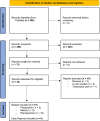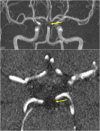A systematic review of the Contour Neurovascular System for the treatment of intracranial aneurysms
- PMID: 40262194
- PMCID: PMC12014585
- DOI: 10.1177/19714009251336321
A systematic review of the Contour Neurovascular System for the treatment of intracranial aneurysms
Abstract
BackgroundThis systematic review aims to reflect the current state of the literature on use and efficacy of the Contour Neurovascular System (CNS), an endovascular implant specifically developed for the treatment of intracranial wide-neck aneurysms.MethodsWe included manuscripts from a PubMed search with the terms "contour AND aneurysm." Manuscripts that did not refer to the CNS were excluded via screening.The number of interventions from included studies was calculated and, where possible, occlusion rates of aneurysms, used CNS sizes, and complications were recorded.ResultsWe found a total number of 23 studies with 625 patients and 661 aneurysms treated with CNS (122 ruptured). The number of studies with low bias and sufficient randomization is very small. Only two prospective studies with 43 patients could be identified. The mean aneurysm size was 6.4 mm (height), 5.5 mm (dome size), and 3.9 mm (neck size). Most used CNS sizes were "7" and "9." A complete occlusion result was achieved in 61% of patients in the long-term controls; in 28%, an adequate occlusion with a small neck rest was reported.ConclusionsThe preliminary results of the CNS are promising. However, these findings need to be proven in larger, prospective studies.
Keywords: Contour Neurovascular System; flow disruption; intracranial aneurysm; systematic review.
Conflict of interest statement
The author(s) declared the following potential conflicts of interest with respect to the research, authorship, and/or publication of this article: DB and RS are consultants of Stryker and received speaker honoraria. DB is also consultant of WallabyPhenox, Balt Group, Acandis, and Embocraft. All other authors declare that they have no conflicts of interest.
Figures




Similar articles
-
Coil embolization for intracranial aneurysms: an evidence-based analysis.Ont Health Technol Assess Ser. 2006;6(1):1-114. Epub 2006 Jan 1. Ont Health Technol Assess Ser. 2006. PMID: 23074479 Free PMC article.
-
Contour-Assisted coiling with jailed microcatheter May result in better occlusion (CoCoJaMBO) in wide-necked intracranial aneurysms: Proof of principle and immediate angiographic results.Interv Neuroradiol. 2023 Feb;29(1):79-87. doi: 10.1177/15910199211069782. Epub 2022 Jan 11. Interv Neuroradiol. 2023. PMID: 35014885 Free PMC article.
-
Comparison of the Contour Neurovascular System and Woven EndoBridge device for treatment of wide-necked cerebral aneurysms at a bifurcation or sidewall.J Neurosurg. 2023 Jan 27;139(2):563-572. doi: 10.3171/2022.12.JNS222268. Print 2023 Aug 1. J Neurosurg. 2023. PMID: 36708532
-
Acutely Ruptured Intracranial Aneurysms Treated with Flow-Diverter Stents: A Systematic Review and Meta-Analysis.AJNR Am J Neuroradiol. 2018 Sep;39(9):1669-1675. doi: 10.3174/ajnr.A5730. Epub 2018 Jul 26. AJNR Am J Neuroradiol. 2018. PMID: 30049721 Free PMC article.
-
A systematic review and meta-analysis of Comaneci/Cascade temporary neck bridging devices for the treatment of intracranial aneurysms.Front Hum Neurosci. 2023 Sep 25;17:1276681. doi: 10.3389/fnhum.2023.1276681. eCollection 2023. Front Hum Neurosci. 2023. PMID: 37817943 Free PMC article.
References
Publication types
LinkOut - more resources
Full Text Sources

